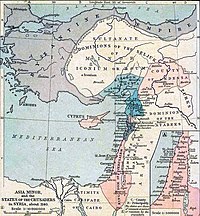Siege of Damascus (1148)
| Siege of Damascus | |||||||
|---|---|---|---|---|---|---|---|
| Part of the Second Crusade | |||||||
 Crusaders intended for Edessa, seen here on the right of this map (c.1140), were diverted by King Baldwin III of Jerusalem to Damascus. |
|||||||
|
|||||||
| Belligerents | |||||||
|
Crusaders |
Muslim forces: |
||||||
| Commanders and leaders | |||||||
|
|
Mu'in ad-Din Unur Saif ad-Din Ghazi I Nur ad-Din Zangi |
||||||
| Strength | |||||||
| 50,000 | Unknown | ||||||
| Casualties and losses | |||||||
| Unknown | Unknown | ||||||
Muslim victory
Crusaders
Muslim forces:
The Siege of Damascus took place between 24 July and 29 July 1148, during the Second Crusade. It ended in a decisive crusader defeat and led to the disintegration of the crusade. The two main Christian forces that marched to the Holy Land in response to Pope Eugene III and Bernard of Clairvaux's call for the Second Crusade were led by Louis VII of France and Conrad III of Germany. Both faced disastrous marches across Anatolia in the months that followed, with most of their armies being destroyed. The original focus of the crusade was Edessa (Urfa), but in Jerusalem, the preferred target of King Baldwin III and the Knights Templar was Damascus. At the Council of Acre, magnates from France, Germany, and the Kingdom of Jerusalem decided to divert the crusade to Damascus.
The crusaders decided to attack Damascus from the west, where orchards would provide them with a constant food supply. Having arrived outside the walls of the city, they immediately put it to siege, using wood from the orchards. On 27 July, the crusaders decided to move to the plain on the eastern side of the city, which was less heavily fortified but had much less food and water. Nur ad-Din Zangi arrived with Muslim reinforcements and cut off the crusader's route to their previous position. The local crusader lords refused to carry on with the siege, and the three kings had no choice but to abandon the city. The entire crusader army retreated back to Jerusalem by 28 July.
The two main Christian forces that marched to the Holy Land in response to Pope Eugene III and Bernard of Clairvaux's call for the Second Crusade were led by Louis VII of France and Conrad III of Germany. Conrad's force included Bolesław IV the Curly and Vladislaus II of Bohemia, as well as Frederick of Swabia, his nephew who would become Emperor Frederick I. The crusade had been called after the fall of the County of Edessa on 24 December 1144. The crusaders marched across Europe and arrived at Constantinople in September and October 1147.
...
Wikipedia
